|
Canadian Antique Phonograph Project:
Made in British Columbia
by Bill Pratt
Relying on a range of resources - advertisements and articles in contemporary newspapers; reports in phonograph and furniture journals of the period, especially Canadian Music Trades Journal, Talking Machine World and Canadian Furniture World and the Undertaker; Internet Archive; listings on Facebook Marketplace, Craigslist and Kijiji; photographs submitted by CAPS members - the Canadian Antique Phonograph Project (CAPP) documents phonographs that were made in Canada from 1898 to 1928.
The majority of Canadian-made phonographs during this period were manufactured in the province of Ontario. Currently the project has identified 131 brands with an Ontario source. Quebec-manufactured phonographs are a distant second with 38, although there are likely many yet-to-be-discovered machines that were not advertised in contemporary Quebec newspapers. 20 brands were manufactured in Manitoba while Nova Scotia and Alberta each account for a single phonograph brand.
This article provides some early research on four companies that manufactured phonographs in the province of British Columbia: Autophone, Premier, Classic and Masterpiece.
Autophone
The only cylinder player among Canadian-made phonographs was the Autophone which was first manufactured in Canada by the Dominion Autophone Company Ltd., Vancouver, B.C. beginning in early 1915.
The Province (Vancouver), June 18, 1913, p. 17
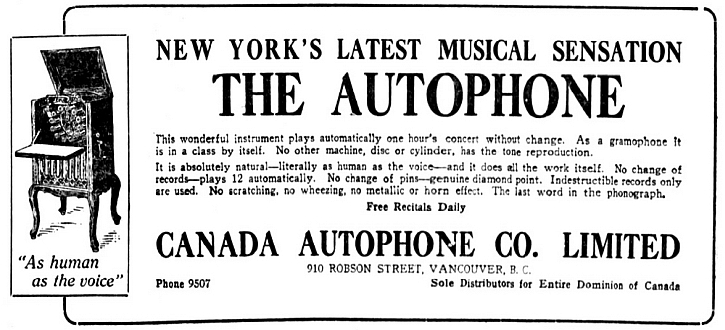
|
|
On January 12, 1909, Patent No. 909,455 was granted to Cornelius Reinhardt, assignor to the Autophone Company of San Francisco, California, for a "magazine-phonograph".
The object of this invention is to provide an apparatus whereby a considerable number of sound-producing cylinders may be arranged in such relation that any one of them may be brought into proper position for co-operation with the reproducer or, if preferred, by which said cylinders may be so brought into such position in succession automatically. (From the patent description)
Victoria Daily Times, March 30, 1915, p. 5
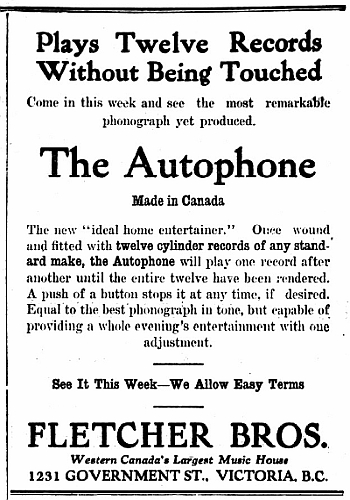
|
|
The Autophone was designed to play 12 Blue Amberol or other hard cylinder records automatically in sequence. On average, a record will play for about four minutes, enabling the machine to produce music unattended for 45+ minutes on a single winding. Talking Machine World described it as the first machine to use a concealed horn cabinet and the first to use a diamond point in the reproducer. It was manufactured by the American Phonograph Co., 102 West 101st Street, New York, NY.
The Autophone was put on the Canadian market in 1913 by the Canada Autophone Co. Limited, 910 Robson Street, Vancouver, B.C. which had obtained the patent rights for the whole of Canada and the Pacific Coast States. Advertisements for the machine began to appear in British Columbia newspapers - Victoria Daily Times, Vancouver Sun and The Province - beginning in May, 1913: "Ideal Home Entertainer, The Autophone, As Human as the Voice."
In 1914, the Canada Autophone Company sold the patent rights to the Dominion Autophone Company. In July, 1914, the National Post Toronto newspaper announced that "under the name of the Dominion Autophone Co. there has been incorporated a Canadian company to manufacture, produce and sell what is known as the 'Autophone'." Initially, Dominion had a contract with the manufacturers in New York to supply the instruments to the Canadian company at a specified price which allowed a very satisfactory profit and the U.S. house was bound to deliver to the Canadian company up to half of its entire production. Dominion planned to supply its own records which they would manufacture. It was proposed to later assemble machines in Canada and manufacture outright when the business warranted. "In the event of manufacturing, the company have a contract with the American corporation to duplicate their plant in Canada, without any cost to the Canadian company for the patent rights or royalties, simply the actual cost of construction." By March, 1915, an ad in the Victoria Daily Times newspaper by Fletcher Bros., Western Canada's Largest Music House, indicated that the Autophone was "Made in Canada" which brought it into the Canadian Antique Phonograph Project.
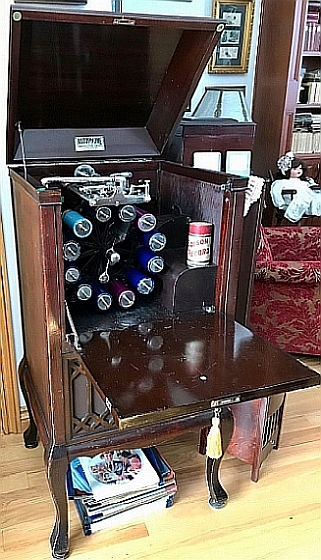
|
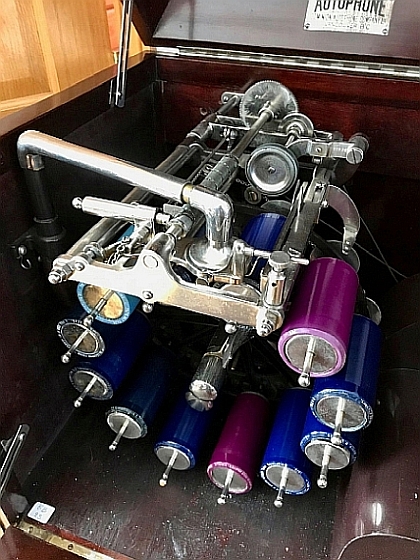
|
|
Autophone manufactured by Dominion Autophone Company Ltd., Vancouver, B.C.
|
|
The Autophone was not the first of the multiple-cylinder playing phonographs. It was a descendant of the coin-operated Multiphone which was offered in late 1906 by the Multiphone Operating Company of New York City. The 8-foot high, 3-foot wide lyre-shaped Multiphone of 1907 was a behemoth. A spring motor supplied the power and 24 two-minute cylinders, arranged on a vertically-mounted revolving carousel, like the Autophone, would play automatically on a single winding. Later models were more rectilinear-shaped and played 12 four-minute cylinders. By May, 1908 the original company was bankrupt and reorganized. By 1913, the current manufacturer of the Multiphone, the American Phonograph Company of New York, offered a scaled-down version called the Autophone. It is best known in its home entertainment model (illustrated).
ID plate on the Dominion Autophone
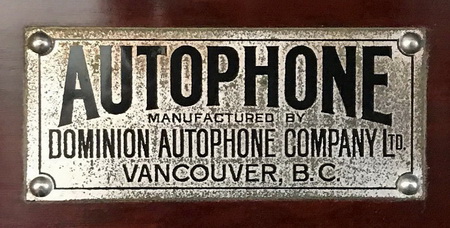
|
|
Talking Machine World described an early amusement parlour in Hamilton, Ontario that featured the Multiphone, the newest entertainment device:
The Canadian Multiphone Co., whose concern owns the Canadian patents of the multiphone, has opened up a one-cent amusement arcade in Hamilton. This is the first hall in Canada to be equipped with the multiphone, and it is very handsomely equipped. Twenty-one machines have been installed and as each machine has a capacity of twelve records the arcade's patrons have an extensive variety from which to choose. The best records will be put at the disposal of the public as they come out. E. R. Marshall, secretary of the United Multiphone Co., of New York, superintended the opening of the arcade at Hamilton. (Talking Machine World, February 15, 1907, p. 62)
The extraordinary Multiphone of 1907
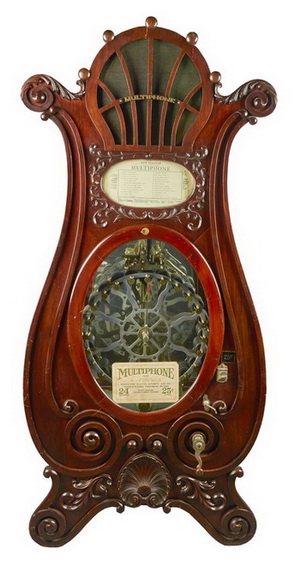
|
|
Another "multiplex" talking machine designed to carry several records at one time, playing them one after the other without rewinding until the series was exhausted, was brought to the market about 1907 by a U.S. inventor, George Gomber.
George Gomber invented a new form of multiplex phonograph, which he has since manufactured, in a small way, for the trade of this country [United States], having disposed of the patent rights in Canada and Germany some time ago. The machine is especially designed for use in arcades, cafes, etc., and is coin-operated, the power being gained from a spring motor wound up with a crank. A dial is provided bearing the names of twelve selections, and after the coin is placed in the machine, a pointer may be moved to the selection desired, a push on the handle starting the mechanism.
Numerous advantages are claimed for the machine. In the first place, instead of having only one selection, the customer has his choice of twelve selections. The ordinary phonograph records can be placed in and taken out at will. There are also two sets of ear tubes, and a person dropping a cent can not only use one set of tubes, but on the opposite side is the other set, which can be placed in the ears of anyone desired. On the top of the machine is also the ordinary horn. In case the person dropping a penny prefers to play the music or song so that all in the room can hear it, it can readily be arranged by just changing the sound from the tube to the horn. (Talking Machine World, June 15, 1910, p. 4)
While Talking Machine World reported that Canadian companies owned the patent rights to both the Multiphone and Gomber's multiplex phonograph, it is not known whether either machine was manufactured in Canada.
Premier
The Premier phonograph was manufactured in Victoria, British Columbia by the Premier Phonograph Company. In August 1920, a competition was held to identify the "most popular native daughter" in Victoria, B.C. The girls in the contest were expected to get signatures from locals to a pledge that they would use Made-in-Victoria goods. Local manufacturing firms put up candidates. First prize in the contest was $100 "augmented by a PREMIER phonograph invented in Victoria by P.E. Gorge [sic] and manufactured by the Premier Phonograph Co., 3171 Highview Street, Victoria, and donated by that company." (Victoria Daily Times, August 23, 1920, p. 7) The prize phonograph was displayed in the window of Jay's Ltd., Fort Street.
In 1924, the Victoria Daily Times provided a short history of the growth of this local industry:
Victoria Daily Times, December 20, 1920, p. 7

|
|
The manager of the company is P.E. George, born in London, England, who came to British Columbia to take up woodwork and contracting. In 1917 he conceived the idea of making phonographs, and worked out many ideas in his spare time. After twelve months' bench-work, he developed an excellent amplifier or horn made with British Columbia spruce, which has since been proclaimed by eastern manufacturers to be the most desirable wood for tone amplification in phonographs. In January 1918, he completed his first batch of six phonographs, and decided to name the phonograph "Premier", its protection being obtained for twenty-five years.
No one, however, says Mr. George, seemed to wish for a local phonograph, and a well-known business man here stated that phonographs could not be made in Victoria. When he saw my first sample he complimented me, but as the music stores in our city would not handle the 'Premier', he got discouraged and took a position with the Foundation Company, Limited. Later, however, he started up again with more capital, and turned out a batch of fifty, receiving financial help from the Provincial Government, in the shape of an industrial loan, with which he made arrangements with the Canadian Western Woodworkers, Limited, Garbally Road, to connect up with them and manufacture cabinets in large quantities. The plant at his disposal is capable of turning out up to one thousand phonographs per year. The cabinet-makers, being Old Country trained artisans, it is found, upon inspection, that all 'Premiers' show the ear-mark of quality in cabinet work and material. The steady increase in output each year has been brought about in no small measure by the clear, mellow tone of the 'Premier', which is now turned out in seven models, including the well-known Electrophone model, which has several features exclusively 'Premier'. We also make and stock a Radio phonograph which has become very popular.
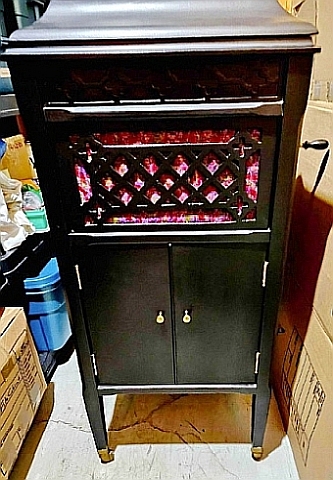
|
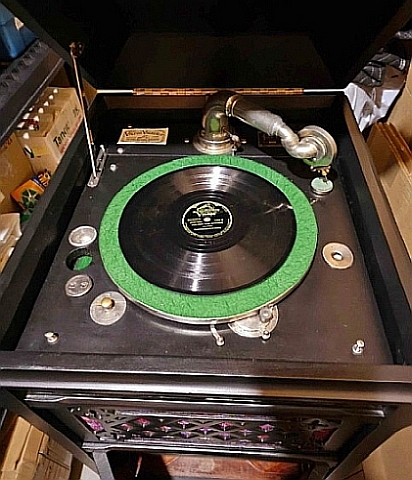
|
|
A Victoria-made Premier phonograph for sale through Facebook Marketplace in Surrey, B.C.
|
|
This plant was the first to manufacture phonographs for the market, west of Winnipeg, and are at present the only manufacturers of phonographs or radio phonographs in British Columbia, sending shipments to Edmonton, Vancouver, New Westminster, Kamloops, etc., etc. Every 'Premier' manufactured by the Canadian Western Woodworkers, Limited, is thoroughly inspected in its course through the factory, and finally tested out on completion. Have also developed a repair department for the expert repair of all makes of phonographs. The 'Premier' is made in three standard finishes, but special models are made to suit the purchaser.
ID plate on the Surrey Premier
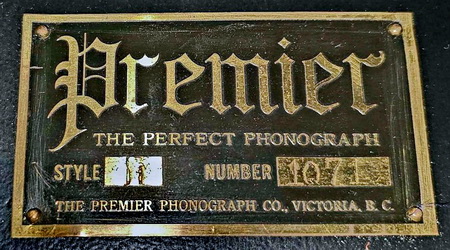
|
|
The general question put by the majority of the public: 'Is the radio affecting the phonograph business?' The phonograph dealer and manufacturer can only answer that query, his steady increase in the sale of records, which is partly created by the Radio Broadcaster, who suggests these records to the public, and the large demand for phonographs seem to point out that the radio is not affecting phonograph sales. It is reasonable to expect that the public will have what music they wish, and radio broadcasting practically being confined to the evening hours, those round the house during the day fall back on the old reliable phonograph and its records. Galli-Curci, Caruso, Melba, Paderewski, etc., are only to be had on the phonograph record, thus one cannot help seeing that a great future for the manufacturer and dealer of high grade phonographs is assured. Mr. George believes that the big demand with be for the radio-phonograph combination, which will give the purchaser anything he may desire in music, addresses, etc. The phonograph is a household necessity today; it brings music to the home and increases the desire for good music.
Cabinet logo on an Ontario Premier
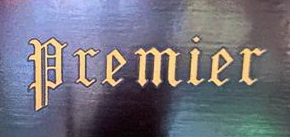
|
|
In conclusion, it can be said, owing to the fact of the 'Premier' being a local product, that, as Abraham Lincoln once said: 'I do not know much about the tariff, but this I do know: when we buy manufactured goods abroad, we get the goods and the foreigner gets the money. When we buy goods of home product we get both the goods and the money.' (Victoria Daily Times, November 8, 1924, p. 20)
There was also a Premier Phonograph Company in Toronto, Ontario, which was documented by Ottawa historian, Jennifer Mueller. Its cabinet logo used the same Gothic font as seen in the B.C. Premier's ID plate and, on first glance, the word "Premier" is identical for both companies. On closer inspection, the "P", especially, is different. But it's curious all the same. Was there some connection between the two companies even though the documentation is clear that manufacturing occurred separately in each province?
Classic
The Province, (Vancouver), April 19, 1923, p. 22
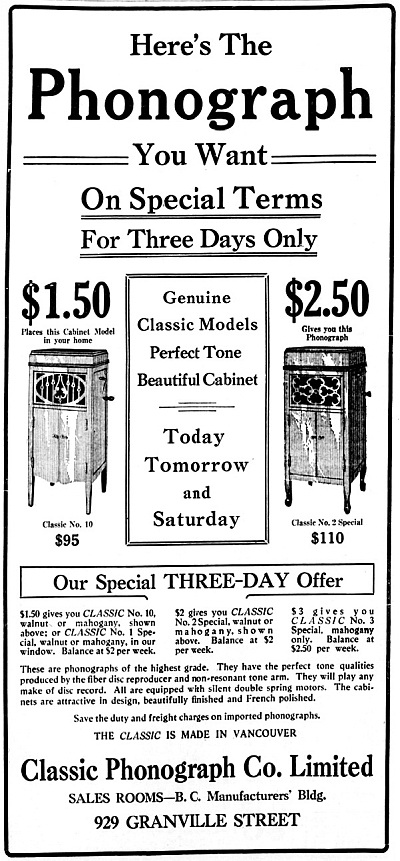
|
|
The Classic phonograph was introduced to the public in late 1921. It was manufactured by the Artcraft Phonograph Company Limited in their factory in the B.C. Manufacturers' Building, 929 Granville Street, Vancouver, B.C. On January 15, 1922 they announced daily demonstrations "of this marvellous instrument" in their showrooms at 985 Granville. They also carried a full line "of the new Apex records". "Selling direct from the factory and eliminating the middlemen's profits, the Artcraft Company are enabled to sell the Classic for less than half of the price of other phonographs of the old style." (Vancouver Sun, February 5, 1922, p. 22) In late January the demand was so great for their $85.00 "C" model phonograph that they issued a public apology for their inability to meet promised delivery because they were working overtime on a new period Console model.
In March, 1922 the company announced that "The Tecumseh and Bridgeport schools have recently installed the new 'Classic' phonographs, manufactured in Vancouver by the Artcraft Phonograph Co. Ltd. This company makes a special model for school use which has a full tone volume and yet is light enough for the children to carry from one class room to another. Both pupils and staff are now boosters for British Columbia's newest industry." (Vancouver Sun, March 12, 1922, p. 4)
At the same time they promoted extensively a model for exclusive use by the Sun Radio Service for its daily radio concerts. "With the advent of radio came a new use for the phonograph, this instrument now being used by all broadcasting stations in sending out radio concerts." (Vancouver Sun, March 26, 1922, p. 29) Daily newspaper announcements provided the programme for the Vancouver Sun's nightly broadcast.
On May 21, 1922 Vancouver Sun reported that "arrangements were completed last week whereby Mr. A.B. Scott, the well-known eastern manufacturer, secured a substantial interest in the Artcraft Phonograph Co., Ltd., the local company manufacturing in Vancouver the new 'Classic' phonographs..... Mr. Scott is taking an active part in the management of the company." In fact, he became its president. In August they changed their name to the Classic Phonograph Company Limited.
By early 1923 there were at least 6 models of the Classic phonograph, 4 upright and 2 console, ranging from $95.00 to $250.00. Two days before Christmas, 1923, the company announced "To every purchaser of a Classic Phonograph we will give FREE a nice large turkey. You may pick your own. Remember we supply your Christmas dinner and the music as well. (Vancouver Sun, December 23, 1923, p. 21) At this point newspaper ads petered out and we can only assume that the company struggled into 1924 and then ceased production.
I have yet to turn up photographs of an actual Made in Vancouver Classic phonograph. Keep your eyes open. This can be your contribution to the Canadian Antique Phonograph Project.
Masterpiece
Vancouver Sun, February 18, 1923, p. 4
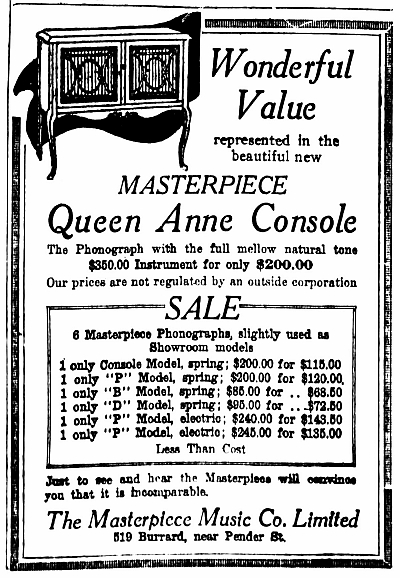
|
|
The fourth entry in our brief survey of Made in British Columbia phonographs is the Masterpiece which was manufactured by the Masterpiece Music Company, 519 Burrard Street, Vancouver, B.C. and first offered to the public in mid-1921. The Masterpice had the advantage of a ready-made market as demonstrations of this phonograph were available at all B.C. electric showrooms throughout the province.
All off-brand phonographs hyped some unique feature in their advertising that they claimed made their machine stand out from the major players. The Masterpiece lauded its tone - specifically, the use of a disc of vegetable fibre in the reproducer.
Many phonographs have been given wide publicity on the supremacy of their tone, but by actual comparison, which you yourself can make, any time you like, you will find the Masterpiece actually is the only perfect reproducer of the human or instrumental voice.
The old mica reproducer, common to all other instruments, is done away with and a disc of vegetable fibre picks up the sound from the graven record and passes it on to the tone chamber.
The Masterpiece is the first and only instrument which entirely and absolutely does away with that metallic note which seemed almost a necessary part of reproduced music. (The Province, November 1, 1921, p. 6)
At least four spring-driven models of the Masterpiece were manufactured and labelled "B", "D", "P" and Console. In February, 1922 they introduced an electrically operated Masterpiece phonograph, also labelled "P", for $195.00 and in March a "Baby Masterpiece" for $125.00 which was particularly suited to the suite or bungalow.
Newspaper ads ceased in late 1923 and, as with the Classic, we can only assume that the short manufacturing lifespan of the Masterpiece was 1921-1923. I am still searching for photographs of a flesh and blood Masterpiece phonograph to enhance the CAPP page.
|